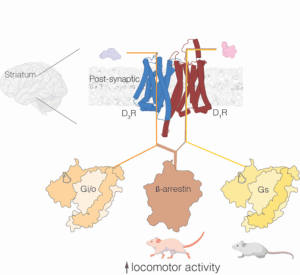 Hot Off the Press – August, 2025
Hot Off the Press – August, 2025
Published in Pharmacological Research by Alexandra Evans and Sergi Ferré , et al. of the NIDA IRP Integrative Neurobiology Section.
Summary
It has been long advocated that the mechanism responsible for the classically established cooperative effect of dopamine D1-like and D2-like receptor agonists in the elicitation of locomotor activity in rodents is the simultaneous activation of stimulatory D1 receptors (D1Rs) in the direct GABAergic striatal efferent pathway and of inhibitory D2Rs in the indirect efferent pathway. This new study demonstrates instead that such a cooperative effect depends on interactions between D1Rs and D3Rs mediated by D1R-D3R heteromers at the same striatal neuronal level. Even more specifically, it demonstrates that locomotor activity in mice depends on β-arrestin recruitment by the D1R in thestriatal D1R-D3R heteromer. These results can have implications for the treatment of L-dopa-induced dyskinesia and Restless Legs Syndrome.
Publication Information
Locomotor activity depends on β-arrestin recruitment by the dopamine D receptor in the striatal D-D receptor heteromer Journal Article
In: Pharmacol Res, vol. 218, pp. 107826, 2025, ISSN: 1096-1186.
